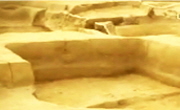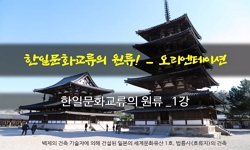Since the period of Japanese occupation, the Twin Tombs(雙陵), in Iksan(益 山), were recognized as the royal tombs of the late Baekje(百濟) period. It was impossible to determine the owner of the tomb at the time of excavation in 1917, but the G...
http://chineseinput.net/에서 pinyin(병음)방식으로 중국어를 변환할 수 있습니다.
변환된 중국어를 복사하여 사용하시면 됩니다.
- 中文 을 입력하시려면 zhongwen을 입력하시고 space를누르시면됩니다.
- 北京 을 입력하시려면 beijing을 입력하시고 space를 누르시면 됩니다.

익산 쌍릉과 출토 인골의 성격에 대한 연구 = A Study on the Twin Tombs of Iksan and the Character of the Recovered Human Bones
한글로보기부가정보
다국어 초록 (Multilingual Abstract)
In 2017, the Great King’s tomb was excavated once again and a previously unknown wooden box containing bones was found within. BNRICH undertook the present research on these bones since, if they belong to the tomb’s owner, they can present a definitive clue to establishing whether or not King Mu was indeed buried in this tomb.
The human bones found in the Great King’s tomb were identified as representing the skeleton of one person. It was identified as a male skeleton based on a non-metric test of the humerus and a metric test of the talus and femur. The results of the analysis of the degree of degeneration of the symphyseal surface and the suricular surface of the hip bone using a test method known to be highly accurate in age estimation, the deceased was confirmed to have been an elderly individual.
The height calculated from the partial measured value of the femur was 161.0~170.1cm. DISH (Diffuse idiopathic skeletal hyperostosis), known to be present predominantly in elderly males, was identified and degenerative extraspinal ossification was also observed. Using radiocarbon dating, the time of death is inferred to be sometime from the early to mid-seventh century.
Based on the results of this study, it can concluded that previous interpretations that identified the Great King’s tomb as the tomb of King Mu were of high probability.
Since the period of Japanese occupation, the Twin Tombs(雙陵), in Iksan(益 山), were recognized as the royal tombs of the late Baekje(百濟) period. It was impossible to determine the owner of the tomb at the time of excavation in 1917, but the Great King’s tomb(大王陵) has generally been regarded as the tomb of King Mu(武王) and the Small King’s tomb(小王陵) to be that of his queen consort.
In 2017, the Great King’s tomb was excavated once again and a previously unknown wooden box containing bones was found within. BNRICH undertook the present research on these bones since, if they belong to the tomb’s owner, they can present a definitive clue to establishing whether or not King Mu was indeed buried in this tomb.
The human bones found in the Great King’s tomb were identified as representing the skeleton of one person. It was identified as a male skeleton based on a non-metric test of the humerus and a metric test of the talus and femur. The results of the analysis of the degree of degeneration of the symphyseal surface and the suricular surface of the hip bone using a test method known to be highly accurate in age estimation, the deceased was confirmed to have been an elderly individual.
The height calculated from the partial measured value of the femur was 161.0~170.1cm. DISH (Diffuse idiopathic skeletal hyperostosis), known to be present predominantly in elderly males, was identified and degenerative extraspinal ossification was also observed. Using radiocarbon dating, the time of death is inferred to be sometime from the early to mid-seventh century.
Based on the results of this study, it can concluded that previous interpretations that identified the Great King’s tomb as the tomb of King Mu were of high probability.
참고문헌 (Reference)
1 최완규, "최근 고고학 성과로 본 백제왕도 익산" 馬韓ㆍ百濟文化硏究所ㆍ익산시 2018
2 이병호, "일제강점기 익산 지역의 고적조사와 쌍릉 출토품" 백제문화연구소 56 (56): 321-348, 2017
3 이주헌, "익산 쌍릉의 유구와 유물에 대하여" 국립전주박물관 2016
4 이문형, "익산 쌍릉(대왕릉)의 새로운 인식" 馬韓ㆍ百濟文化硏究所ㆍ익산시 2018
5 국립문화재연구소, "익산 미륵사지 석탑 사리장엄" 국립문화재연구소ㆍ익산시 2014
6 남북역사학자협의회, "세계문화유산 고구려 고분벽화" 남북역사학자협의회 2013
7 서현주, "부여 능산리고분군의 조사와기록" 부여군 2017
8 김용성, "백제 후기 능묘와 능원의 특성" 국립문화재연구소 47 (47): 68-84, 2014
9 이병호, "백제 사비기 익산 개발 시기와 그 배경" 백제연구소 (61) : 69-105, 2015
10 서현주, "백제 사비기 왕릉 발굴의 새로운 성과와 역사적 해석" 한국고대사학회 (88) : 47-98, 2017
1 최완규, "최근 고고학 성과로 본 백제왕도 익산" 馬韓ㆍ百濟文化硏究所ㆍ익산시 2018
2 이병호, "일제강점기 익산 지역의 고적조사와 쌍릉 출토품" 백제문화연구소 56 (56): 321-348, 2017
3 이주헌, "익산 쌍릉의 유구와 유물에 대하여" 국립전주박물관 2016
4 이문형, "익산 쌍릉(대왕릉)의 새로운 인식" 馬韓ㆍ百濟文化硏究所ㆍ익산시 2018
5 국립문화재연구소, "익산 미륵사지 석탑 사리장엄" 국립문화재연구소ㆍ익산시 2014
6 남북역사학자협의회, "세계문화유산 고구려 고분벽화" 남북역사학자협의회 2013
7 서현주, "부여 능산리고분군의 조사와기록" 부여군 2017
8 김용성, "백제 후기 능묘와 능원의 특성" 국립문화재연구소 47 (47): 68-84, 2014
9 이병호, "백제 사비기 익산 개발 시기와 그 배경" 백제연구소 (61) : 69-105, 2015
10 서현주, "백제 사비기 왕릉 발굴의 새로운 성과와 역사적 해석" 한국고대사학회 (88) : 47-98, 2017
11 김주성, "백제 무왕의 정국운영" 신라사학회 (16) : 261-286, 2009
12 노중국, "백제 무왕의 出系와 천하관" 백제학회 (25) : 5-29, 2018
13 강종원, "백제 무왕대의 정국변화와 미륵사 조영" 백제문화연구소 1 (1): 285-310, 2016
14 김수태, "백제 무왕대의 대신라 관계" 백제문화연구소 1 (1): 61-93, 2010
15 김낙중, "묘제(墓制)와 목관(木棺)을 통해 본 익산 쌍릉(益山 雙陵)의 의미" 국립문화재연구소 47 (47): 162-177, 2014
16 국립문화재연구소, "국역 국조상례보편" 민속원 2008
17 권오영, "고대 동아시아 문명 교류사의 빛 무령왕릉" 돌베개 2012
18 강현숙, "고구려 고분 연구" 서울대학교 대학원 2000
19 李南奭, "陵山里 古墳群과 百濟王陵" 공주대학교 백제문화연구소 29 : 2009
20 山本孝文, "考古學으로 본 百濟王權의 泗沘 經營과 益山資料" 韓ㆍ百濟文化硏究所 20 : 2012
21 최완규, "益山地域의 百濟古墳과 武王陵" 馬韓ㆍ百濟文化硏究所 15 : 2001
22 서정석, "益山 雙陵에 대한 斷想" (11) : 2006
23 국립전주박물관, "益山 雙陵" 국립전주박물관 2015
24 박현숙, "百濟 武王의 益山 경영과 彌勒寺" 고려사학회 (36) : 329-355, 2009
25 남정호, "百濟 武王의 王妃와 義慈王의 生母에 대한 考察" 역사교육학회 (55) : 129-160, 2015
26 강종원, "百濟 武王의 出系와 王位繼承" 호서사학회 (56) : 3-37, 2010
27 吉井秀夫, "百濟 斯麻王" 통천문화사 2001
28 민병승, "武王代 6部체제와 益山" 한국학연구소 34 : 211-237, 2010
29 Brooks, S, "Skeletal age determination based on the os pubis: A comparison of the Acsadi-Nemeskeri and Suchey-Brooks method" 5 : 1990
30 Lee, U. Y, "Sex determination from the talus of Koreans by discrimination function analysis" American Academy of Forensic Sciences 57 : 2012
31 Vance, V. L, "Nonmetric sex determination from the distal and posterior humerus in black and white South Africans" American Academy of Forensic Sciences 56 : 2011
32 Trotter, M, "National Museum of Natural History" Smithsonian Institution Press 1970
33 Lee, J. H, "Estimation of maximum femoral length from fragmentary femur" Korean Association of Physical Anthropology 18 :
34 Kim, M. J, "Diffuse idiopathic skeletal hyperostosis cases found in Joseon Dynasty Human Sample Collection of Korea" 22 : 2012
35 Lovejoy, C. O, "Chronological metamorphosis of the auricular surface of the ilium: a new method for the determination of adult skeletal age at death" American Association of Physical Anthropologists 68 (68): 1985
36 Shin, D. H, "Ancient-to-modern sccular changes in Korean stature" American Association of Physical Anthropologists 147 : 2012
37 Aramaki, T, "Age estimation by ossification of thyroid cartilage of Japanese males using Bayesian analysis of postmortem CT images" the Japanese Society of Legal Medicine 25 : 2017
동일학술지(권/호) 다른 논문
-
- 한국고고학회
- 하근영
- 2018
- KCI우수등재
-
삼국시대 화살통의 등장과 전개과정 — 걸이금구 분석을 중심으로
- 한국고고학회
- 오동선
- 2018
- KCI우수등재
-
물질문화의 유형과 고고학 분석의 단위 — 한국 청동기시대 유형론을 중심으로
- 한국고고학회
- 성춘택
- 2018
- KCI우수등재
-
지석묘사회의 취락패턴과 복합화 — GIS를 활용한 영산강중류역 취락패턴의 재구성
- 한국고고학회
- 강동석
- 2018
- KCI우수등재
분석정보
인용정보 인용지수 설명보기
학술지 이력
| 연월일 | 이력구분 | 이력상세 | 등재구분 |
|---|---|---|---|
| 2023 | 평가예정 | 계속평가 신청대상 (등재유지) | |
| 2018-01-01 | 평가 | 우수등재학술지 선정 (계속평가) | |
| 2015-01-01 | 평가 | 등재학술지 유지 (등재유지) |  |
| 2011-01-01 | 평가 | 등재학술지 유지 (등재유지) |  |
| 2009-01-01 | 평가 | 등재학술지 유지 (등재유지) |  |
| 2007-01-01 | 평가 | 등재학술지 유지 (등재유지) |  |
| 2004-01-01 | 평가 | 등재학술지 선정 (등재후보2차) |  |
| 2003-01-01 | 평가 | 등재후보 1차 PASS (등재후보1차) |  |
| 2001-07-01 | 평가 | 등재후보학술지 선정 (신규평가) |  |
학술지 인용정보
| 기준연도 | WOS-KCI 통합IF(2년) | KCIF(2년) | KCIF(3년) |
|---|---|---|---|
| 2016 | 1.49 | 1.49 | 1.24 |
| KCIF(4년) | KCIF(5년) | 중심성지수(3년) | 즉시성지수 |
| 1.32 | 1.4 | 2.51 | 0.36 |




 스콜라
스콜라







